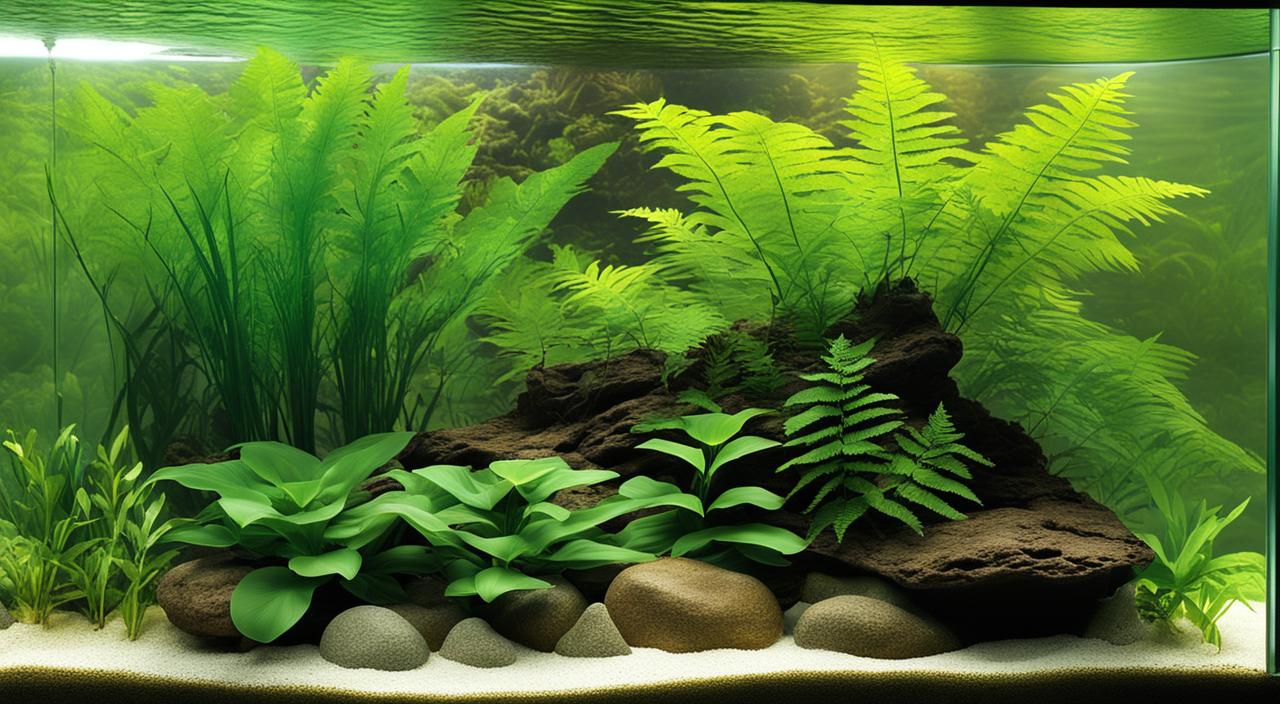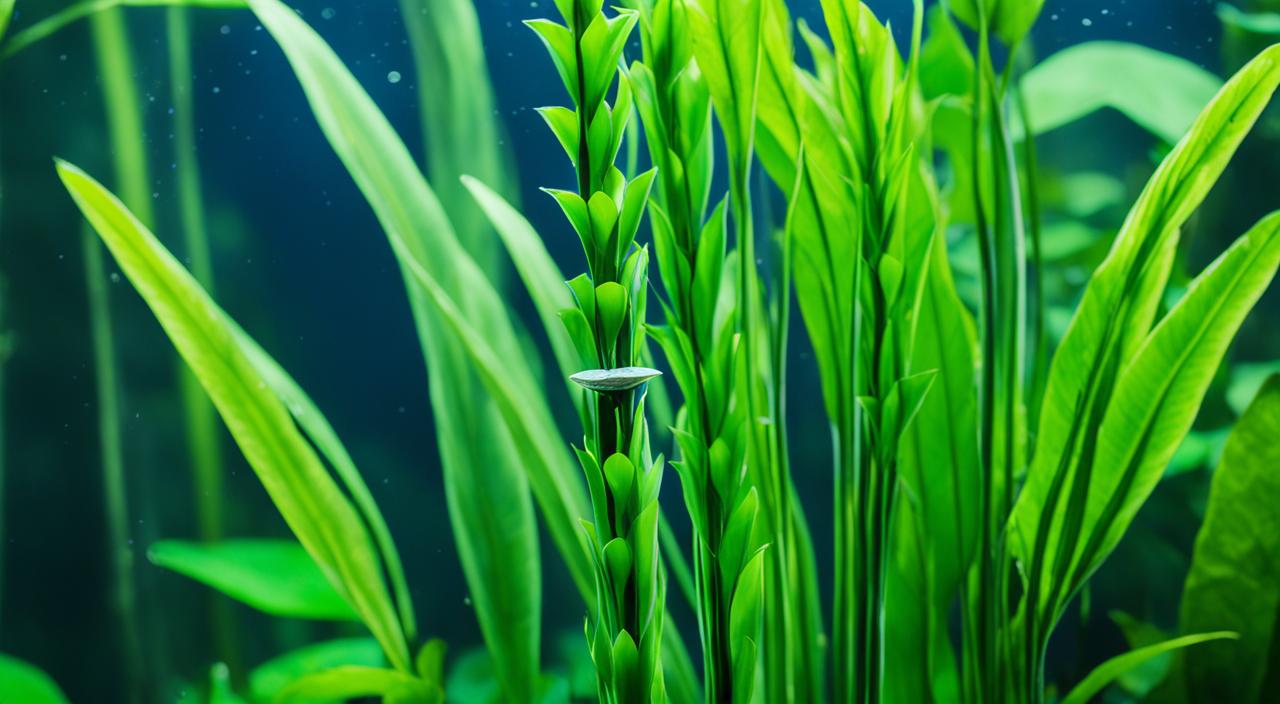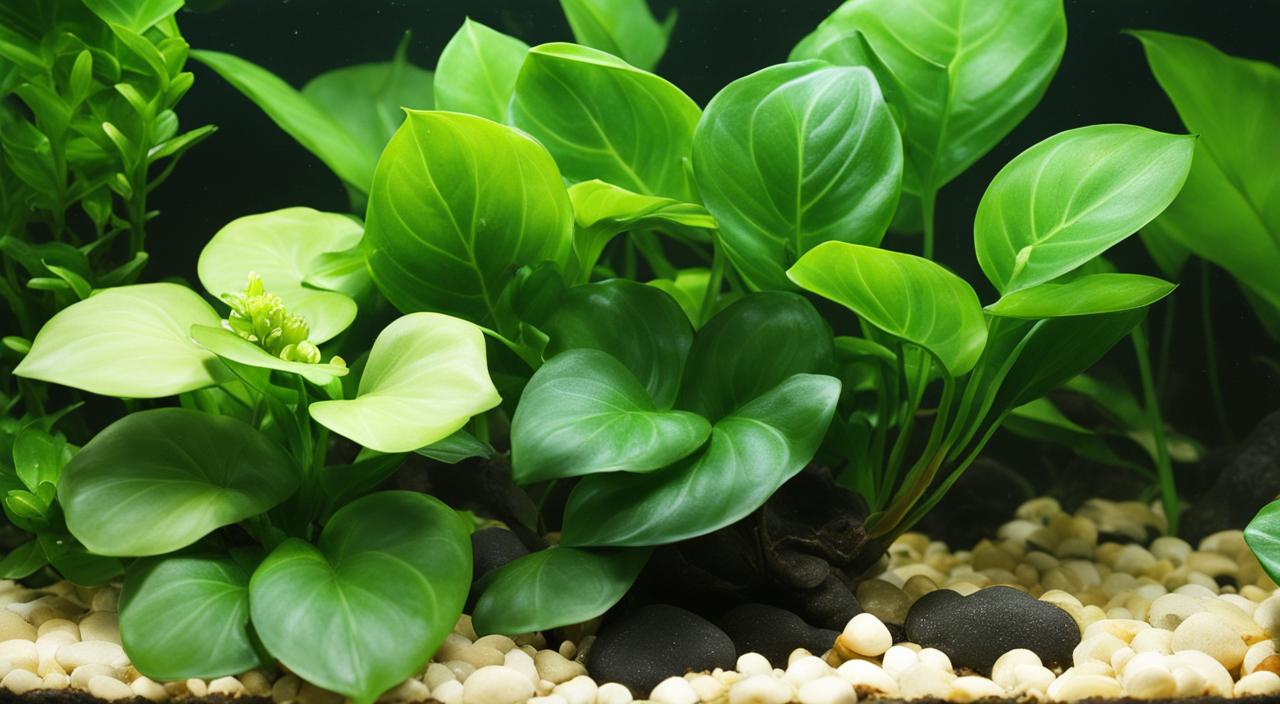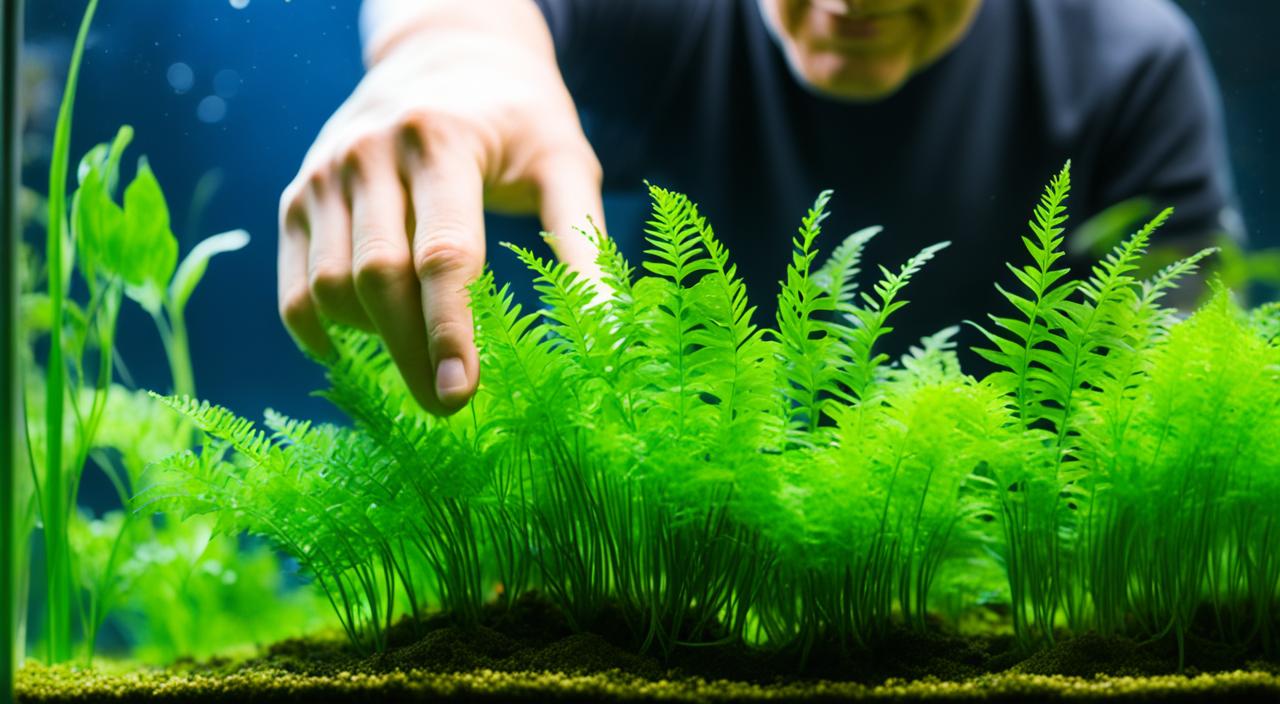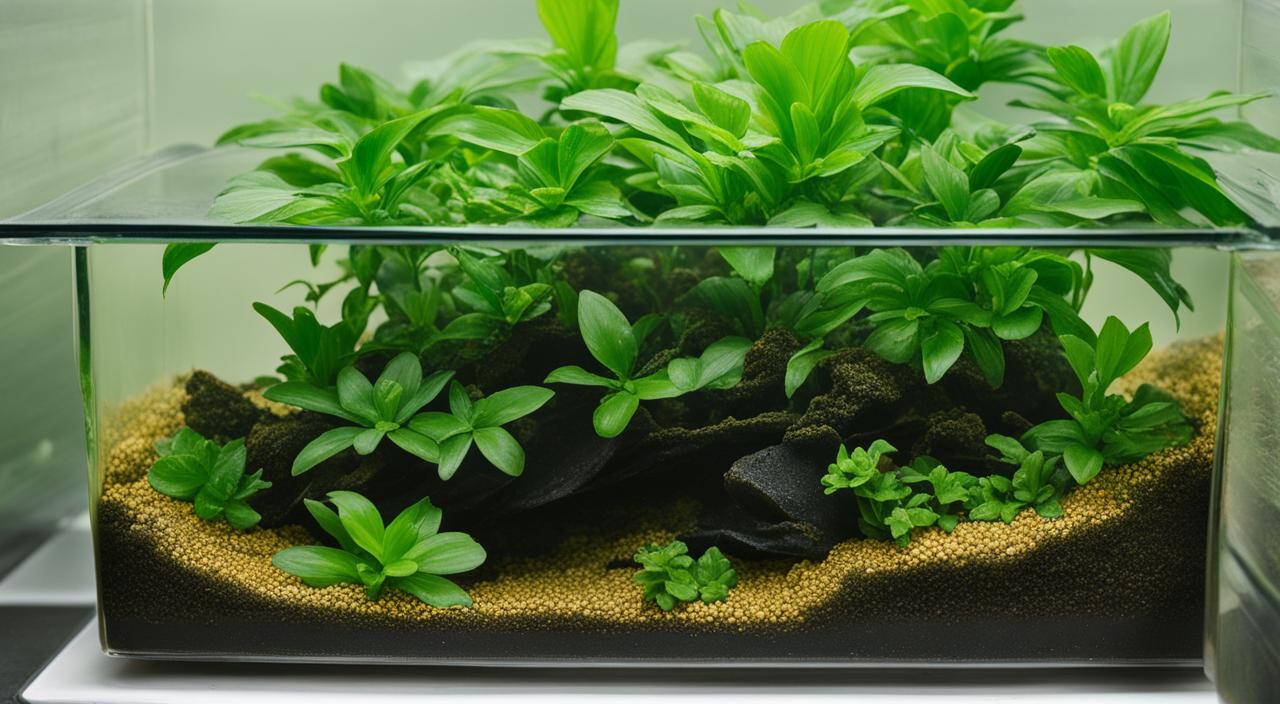Welcome to my guide on caring for Bolbitis heudelotii, an African Water Fern. This versatile aquatic plant is an excellent choice if you want to add a touch of elegance and natural beauty to your aquascape. With its unique morphology and slow growth rate, Bolbitis heudelotii adds a captivating charm to freshwater aquariums.
As an aquarist, I have enjoyed working with Bolbitis heudelotii and witnessing its stunning growth. In this article, I will provide all the essential care tips and advice to help you cultivate this fascinating species in your own tank.
Key Takeaways:
- Bolbitis heudelotii, also known as African Water Fern, is a popular freshwater aquatic plant for aquascaping.
- This plant originates from West Africa and features long, transparent leaves that add a unique touch to aquascapes.
- Bolbitis heudelotii is best attached to rocks or wood and can be grown emersed and submerged.
- It propagates by growing new leaves from the rhizome and can be split to create new plants.
- Proper lighting, water parameters, and care are crucial for the health and growth of Bolbitis heudelotii.
Brief Overview Of Bolbitis heudelotii (African Water Fern)
Bolbitis heudelotii, also known as African Water Fern, is a slow-growing aquatic plant native to West Africa. It features longer and more transparent leaves compared to other Bolbitis species. This plant can be emersed and submerged, making it a versatile choice for freshwater aquascapes. It is best attached to rock or wood for optimal growth. Bolbitis heudelotii propagates by growing new leaves from the rhizome, and the rhizome can be split to create new plants. It thrives in low-light conditions and offers aquariums a unique and natural look.
Bolbitis heudelotii Species Information Table:
| Not necessary, but it can benefit from CO2 supplementation. | Description |
|---|---|
| Scientific Name | Bolbitis heudelotii |
| Common Names | African Water Fern, Congo Fern |
| Origin | Central and West Africa |
| Height | 15-40 cm (6-16 inches) |
| Growth Rate | Slow |
| Colour | Dark green |
| Aquarium Placement | Midground to Background |
| Water Type | Freshwater |
| pH | 6.0 – 7.5 |
| Care Level | Moderate |
| Light Requirements | Low to moderate. Prefers 50-200 PAR, best under 6500K to 7500K lighting for optimal growth. |
| CO2 Requirements | Nutrient-rich water and substrate benefit from liquid fertilizers and root tabs if necessary. |
| Temperature | 20-28°C (68-82°F) |
| Flow Rate | Moderate. Prefers some water movement but not direct strong flow. |
| Propagation | By dividing rhizomes or attaching new growth to rock or wood. |
| Feed Type | Nutrient-rich water and substrate, benefits from liquid fertilizers and root tabs if necessary. |
The light requirements for Bolbitis heudelotii are pretty adaptable. It can thrive in low to moderate lighting conditions. A PAR (Photosynthetically Active Radiation) range of 50-200 is generally sufficient, with the plant showing optimal growth in a specific light spectrum, typically around 6500K to 7500K, mimicking natural daylight and effectively supporting photosynthesis. While Bolbitis heudelotii can grow in lower light, providing a light source closer to the upper end of its preferred spectrum and intensity can enhance its colour and growth rate.
Origins And Habitat
Bolbitis heudelotii is native to the tropics of West Africa, specifically countries like Cameroon, Nigeria, and Gabon. It can grow along the banks of rivers, streams, and other bodies of water in these regions. In its natural habitat, it attaches itself to rocks, roots, and other surfaces, using its rhizome to anchor itself. The warm and humid conditions of West Africa provide an ideal environment for the growth and proliferation of Bolbitis heudelotii.
Morphological Characteristics
Bolbitis heudelotii exhibits distinct morphological characteristics that make it stand out among other aquatic plants. Its long and narrow leaves, which are more transparent than those of other Bolbitis species, can grow up to 8 inches. The delicate and feathery appearance of the leaves is attributed to finely dissected lobes. This plant grows from a rhizome, a horizontal stem that sends out roots and shoots. The rhizome is typically dark brown and can be divided to propagate new plants.
Placement And Lighting
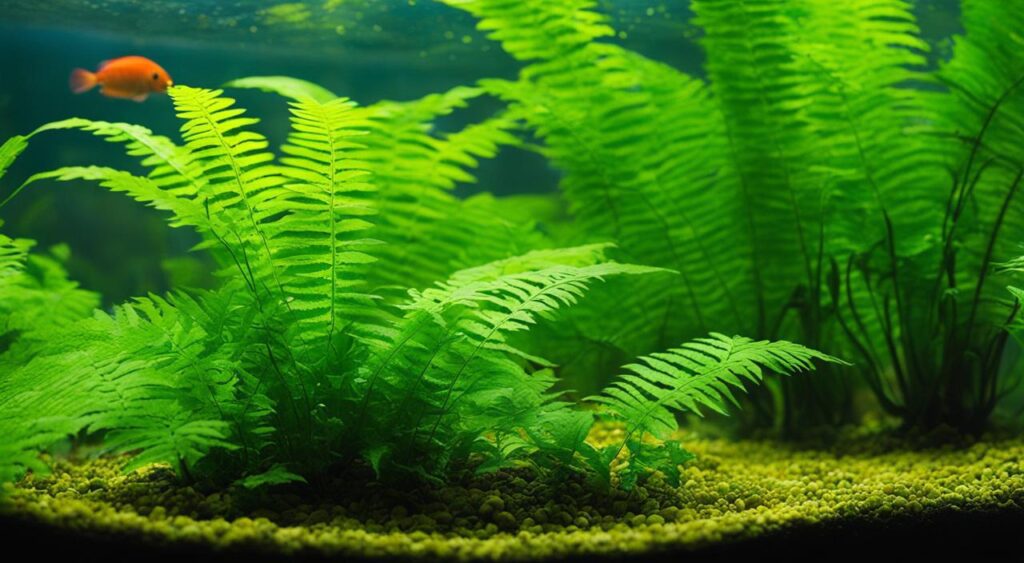
Bolbitis heudelotii, also known as African Water Fern, thrives in specific conditions when it comes to placement and lighting in the aquarium. To ensure optimal growth and health, it is important to consider these factors.
The plant prefers areas of the aquarium that experience higher flow rates. Placing it in these areas helps simulate its natural habitat and provides essential nutrients and oxygen. This can be achieved by strategically positioning the plant near a filter outlet or using a powerhead to create gentle water movement around it.
Regarding lighting, Bolbitis heudelotii does well in low to moderate lighting conditions. It can adapt to various light intensities but should be protected from direct sunlight. Excessive exposure to sunlight can lead to algae growth and damage the leaves. Position the aquarium in a way that avoids direct sunlight, and consider using a light fixture with adjustable settings or diffusers to control the light intensity.
Regarding placement, it is best to attach Bolbitis heudelotii to rocks, roots, or other hardscape elements in the aquarium. Avoid burying the rhizome, as it can cause the plant to die. Instead, leave the rhizome above the substrate to allow it to anchor itself and grow new leaves.
What Are Good Tank Mates?
Bolbitis heudelotii, a versatile aquatic plant, can coexist harmoniously with various species in the aquarium. When considering tank mates for Bolbitis heudelotii, it is vital to choose peaceful freshwater fish and invertebrates that will not harm or disturb the plant’s growth.
Good Tank Mates
- Tetras
- Rasboras
- Guppies
- Dwarf cichlids
- Shrimp
- Snails
These species make excellent companions for Bolbitis heudelotii as they contribute to the overall balance of the aquarium ecosystem and help keep the tank clean.
Fish Species To Avoid
On the other hand, it is advisable to avoid large, aggressive fish species that may damage or uproot the plant. Additionally, certain herbivorous fish like silver dollars or goldfish may consume Bolbitis heudelotii, making them unsuitable tank mates for this fern. Selecting tank mates that are compatible with the plant’s needs is crucial to ensure a thriving and visually appealing aquarium setup.
Feeding (Fertilization)
Bolbitis heudelotii, a low-light aquarium plant, does not require frequent or heavy feeding. It obtains most of its nutrients from the water column and fish waste. Under low to moderate light conditions, the plant can grow well without additional fertilization. However, if you aim for optimal growth and vibrancy, you can consider providing a balanced liquid fertilizer once or twice weekly.
When fertilizing Bolbitis heudelotii, following the instructions on the fertilizer package to determine the correct dosage is essential. Overdosing can lead to nutrient imbalances and algae issues, so avoiding excessive fertilisation is crucial. You can ensure healthy growth and vibrant plant appearance in your aquarium by providing the right amount of nutrients.
CO2 Injection
Bolbitis heudelotii, also known as African Water Fern, is a resilient plant that can adapt to low to moderate levels of CO2 naturally present in most aquariums. However, for those looking to accelerate growth and enhance the colours of their Bolbitis heudelotii, CO2 injection can be a beneficial addition to their setup.
Types of CO2 Injection
There are different types of CO2 injection systems available for aquariums, each with its advantages and considerations:
- Pressurized CO2 Systems: These systems provide precise control over CO2 dosing and are suitable for larger aquariums. They typically consist of a CO2 cylinder, regulator, solenoid valve, and diffuser. Pressurized CO2 systems ensure a steady supply of CO2, promoting optimal plant growth.
- DIY Yeast CO2 Systems: DIY yeast CO2 systems can be a more affordable option for those on a budget. These setups rely on yeast fermentation to generate CO2. While cost-effective, DIY yeast CO2 systems require regular monitoring and maintenance to maintain consistent CO2 levels.
When considering CO2 injection, it’s essential to assess the size of your aquarium and the level of control and maintenance you’re comfortable with. Both pressurized CO2 systems and DIY yeast CO2 systems can benefit the growth and vitality of Bolbitis heudelotii when used correctly.
Care
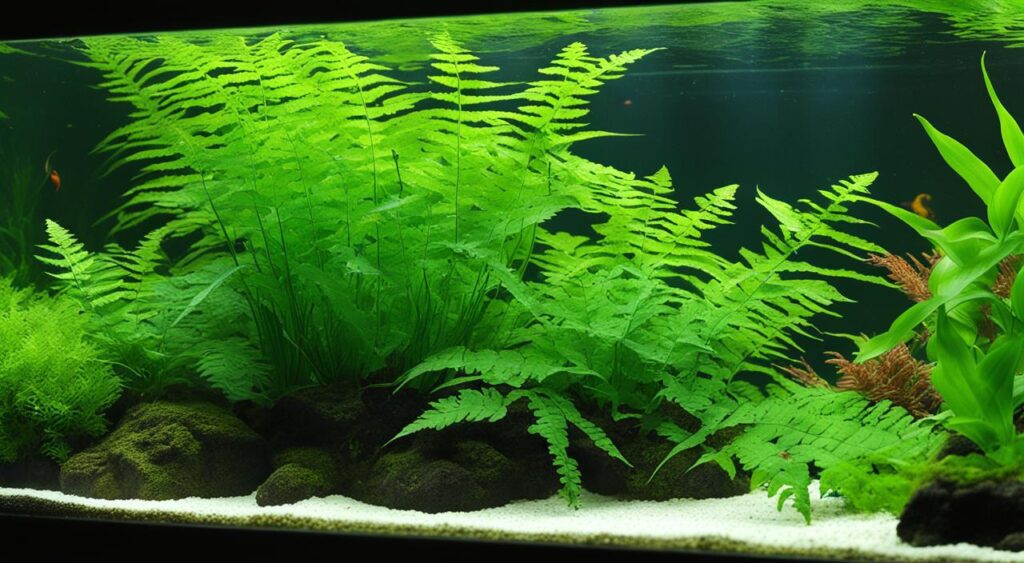
Planted Tank Parameters
Proper care is essential for the health and growth of Bolbitis heudelotii. To ensure optimal conditions for this freshwater fern, maintain the following planted tank parameters:
| Parameter | Range |
|---|---|
| pH | 6-7.5 |
| Water Temperature | 68-82°F (20-28°C) |
| Hardness | 2-15 dGH |
Water Quality
Stable water conditions are crucial for the health of Bolbitis heudelotii. Sudden changes in water parameters can lead to leaf melt and plant decline. Regularly monitor the water quality, including pH, ammonia, nitrite, and nitrate levels. Conduct regular water tests using a reliable test kit and adjust as needed to maintain the appropriate water quality.
Filtration
Proper filtration is essential for maintaining water quality and removing accumulated debris. Choose a filtration system that provides adequate mechanical and biological filtration. Clean or replace filter media regularly to prevent clogging and maintain optimal filtration efficiency.
Flow
A gentle to moderate flow is beneficial for Bolbitis heudelotii. It helps distribute nutrients and oxygen throughout the aquarium, promoting healthy growth. Avoid solid and turbulent currents that uproot the plant or damage the delicate leaves. Adjust the flow rate of filters and water circulation devices to create a gentle, even flow within the aquarium.
Aquarium Maintenance
Testing Water Conditions
Regularly testing the water conditions in your aquarium is essential for the health and well-being of Bolbitis heudelotii. Using a reliable test kit, monitor parameters such as pH, ammonia, nitrite, nitrate, and carbonate hardness. Ensure the water conditions are within the appropriate range for optimal plant growth.
How To Set Up Your Aquarium Tank
When setting up your aquarium tank for Bolbitis heudelotii, several key factors must be considered. First, provide a suitable substrate, such as aquarium soil or fine gravel. This will anchor the plant and provide essential nutrients. Next, attach the Bolbitis heudelotii to the tank’s rocks, wood, or other hardscape elements. This can be done using a fishing line or plant-safe glue. Finally, establish a balanced ecosystem by adding beneficial bacteria, live plants, and appropriate water flow.
Propagation Methods
To propagate Bolbitis heudelotii, you can utilize the plant’s rhizome. The rhizome is the horizontal stem from which leaves and roots develop. During regular aquarium maintenance, carefully split the rhizome into smaller sections, ensuring that each section has healthy leaves and roots. Use a fishing line or plant-safe glue to attach these sections to different surfaces, such as rocks or wood. Over time, these sections will grow into new plants, filling out your aquascape.
Health And Disease
Ensuring the health of Bolbitis heudelotii is essential for its growth and well-being. By understanding the signs of good health and being aware of potential issues, you can provide the necessary care to maintain a thriving aquatic plant.
Signs Of Good Health
- Vibrant green coloration
- New leaf growth
- Sturdy and strong rhizome
When your Bolbitis heudelotii exhibits these characteristics, you can be confident that it is thriving and in optimal health.
Signs Of Poor Health
It’s essential to be aware of signs that your Bolbitis heudelotii may be experiencing poor health:
- Yellowing or browning leaves
- Leaf melt, where the leaves start disintegrating
- Stunted growth or lack of new leaf development
If you observe these signs, it’s crucial to identify the underlying issues and take appropriate action to restore the plant’s health.
Common Health Issues And Treatment
Bolbitis heudelotii may encounter common health issues like nutrient deficiencies, improper lighting, and algae infestations. These issues can be addressed with the following treatments:
| Health Issue | Treatment |
|---|---|
| Nutrient deficiencies | Adjusting the aquarium parameters to provide the required nutrients, such as adding a balanced liquid fertilizer |
| Improper lighting | Choosing the appropriate light intensity and duration for Bolbitis heudelotii, avoiding both too much and too little light |
| Algae infestations | Regularly cleaning the aquarium, controlling nutrient levels, and reducing the amount of light exposure to prevent algae growth |
Identifying and promptly addressing these common health issues can help ensure the long-term health and well-being of your Bolbitis heudelotii.
Plant Pests
While Bolbitis heudelotii is generally resistant to pests, two common plant pests may pose a threat:
- Snails: Snails can feed on the leaves of Bolbitis heudelotii, causing damage and inhibiting growth. Regular inspection and manual removal of snails can help control their population.
- Algae: Algae overgrowth can compete with Bolbitis heudelotii for nutrients and light, impeding plant growth. Maintaining a balanced aquarium ecosystem, controlling nutrient levels, and implementing proper lighting can help prevent algae infestations.
By regularly inspecting your aquatic plants and taking appropriate measures, you can prevent and manage plant pest issues effectively.
Summary
Bolbitis heudelotii, also known as African Water Fern, is a stunning freshwater aquatic plant perfect for aquascaping. It’s unique morphology and slow growth rate make it an excellent addition to any aquarium, adding a touch of elegance and natural beauty. To ensure the well-being of Bolbitis heudelotii, it is crucial to provide the right conditions, including proper lighting, appropriate water parameters, and attentive care.
By placing Bolbitis heudelotii in aquarium areas with higher flow rates and providing low to moderate lighting, you can create an ideal environment for its growth. The plant should be attached to rocks or wood to avoid burying the rhizome. Regular aquarium maintenance, such as testing water conditions and changing water is essential to keep the plant healthy and thriving.
With its versatility and ease of care, Bolbitis heudelotii is suitable for both beginners and experienced aquarists. Its vibrant green colour and delicate foliage make it a captivating addition to any aquascape. Whether you are creating a lush planted tank or a minimalist layout, this fascinating freshwater fern will undoubtedly enhance the overall aesthetics of your aquarium.
FAQ
What is Bolbitis heudelotii?
Bolbitis heudelotii, also known as African Water Fern, is a popular aquatic plant in the aquarium hobby. It is a slow-growing plant with longer and more transparent leaves compared to other Bolbitis species. It can be grown both emersed and submerged and is typically attached to rock or wood.
How does Bolbitis heudelotii propagate?
Bolbitis heudelotii propagates by growing new leaves from the rhizome, a horizontal stem. The rhizome can also be split to create new plants.
What are the care requirements for Bolbitis heudelotii?
Bolbitis heudelotii prefers low to moderate lighting and should be placed in areas of the aquarium with higher flow rates. It can adapt to a wide range of water parameters, with a pH of 6-7.5, water temperature of 68-82°F (20-28°C), and hardness of 2-15 dGH.
Can Bolbitis heudelotii be kept with other fish and invertebrates?
Yes, Bolbitis heudelotii can be combined with peaceful freshwater fish like tetras, rasboras, guppies, and dwarf cichlids. Shrimp and snails also make suitable tank mates. However, it’s important to avoid large, aggressive fish species and herbivorous fish like silver dollars or goldfish.
Does Bolbitis heudelotii require CO2 injection?
Bolbitis heudelotii does not require CO2 injection to grow and thrive. It can adapt to the natural CO2 levels present in most aquariums. However, CO2 injection can promote faster growth and more vibrant colors.
How often should Bolbitis heudelotii be fertilized?
Bolbitis heudelotii does not require frequent or heavy feeding. It can derive most of its nutrients from the water column and fish waste. However, for optimal growth, providing a balanced liquid fertilizer once or twice a week is recommended.
How can Bolbitis heudelotii be propagated?
Bolbitis heudelotii can be propagated by splitting the rhizome into smaller pieces and attaching them to different surfaces. This can be done during regular aquarium maintenance.
What are the signs of good health in Bolbitis heudelotii?
Signs of good health in Bolbitis heudelotii include vibrant green coloration, new leaf growth, and a sturdy rhizome.
What are the common health issues and treatment for Bolbitis heudelotii?
Common health issues for Bolbitis heudelotii include nutrient deficiencies, improper lighting, and algae infestations. These issues can be addressed by adjusting the aquarium parameters and providing proper care.
How should the water quality be maintained for Bolbitis heudelotii?
To maintain water quality for Bolbitis heudelotii, regular water changes of around 10-20% every 1-2 weeks and proper filtration are important. Stable water conditions and removal of toxins or pollutants are essential for the health of the plant.
Does Bolbitis heudelotii require CO2 injection for growth?
Bolbitis heudelotii does not require CO2 injection to grow. It can adapt to low to moderate CO2 levels naturally present in most aquariums. However, if faster growth and more vibrant colors are desired, CO2 injection can be considered.

